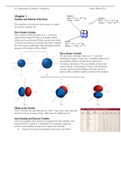Samenvatting
Essentials of Organic Chemistry (MOL101) Summary of all lectures
Summary of all lectures of the course Essentials of Organic Chemistry (MOL101) that is given in the 3rd year of the bachelor biology. Great for people who struggle with big chunks of text. Lots of pictures and bullet points.
[Meer zien]





